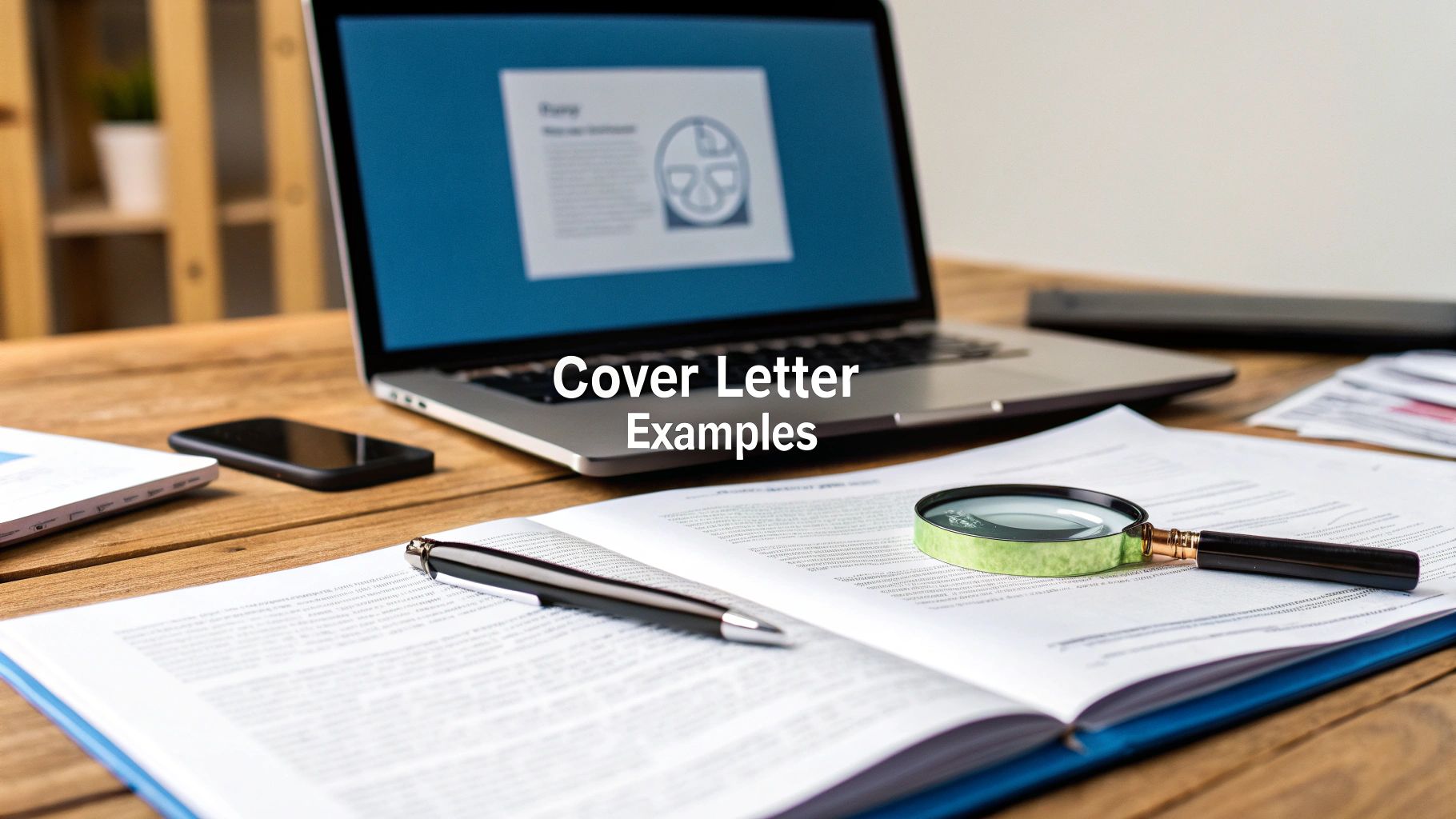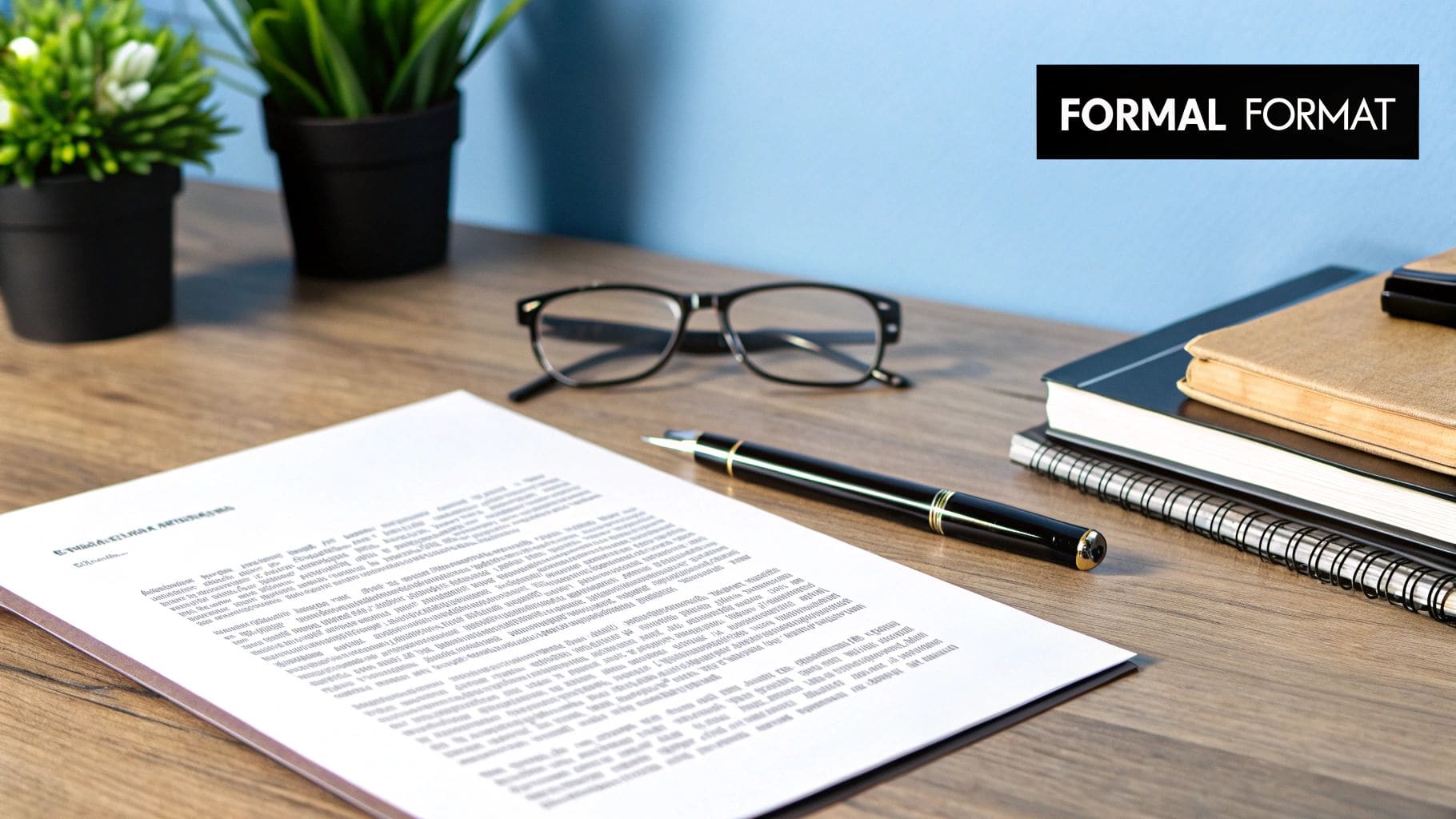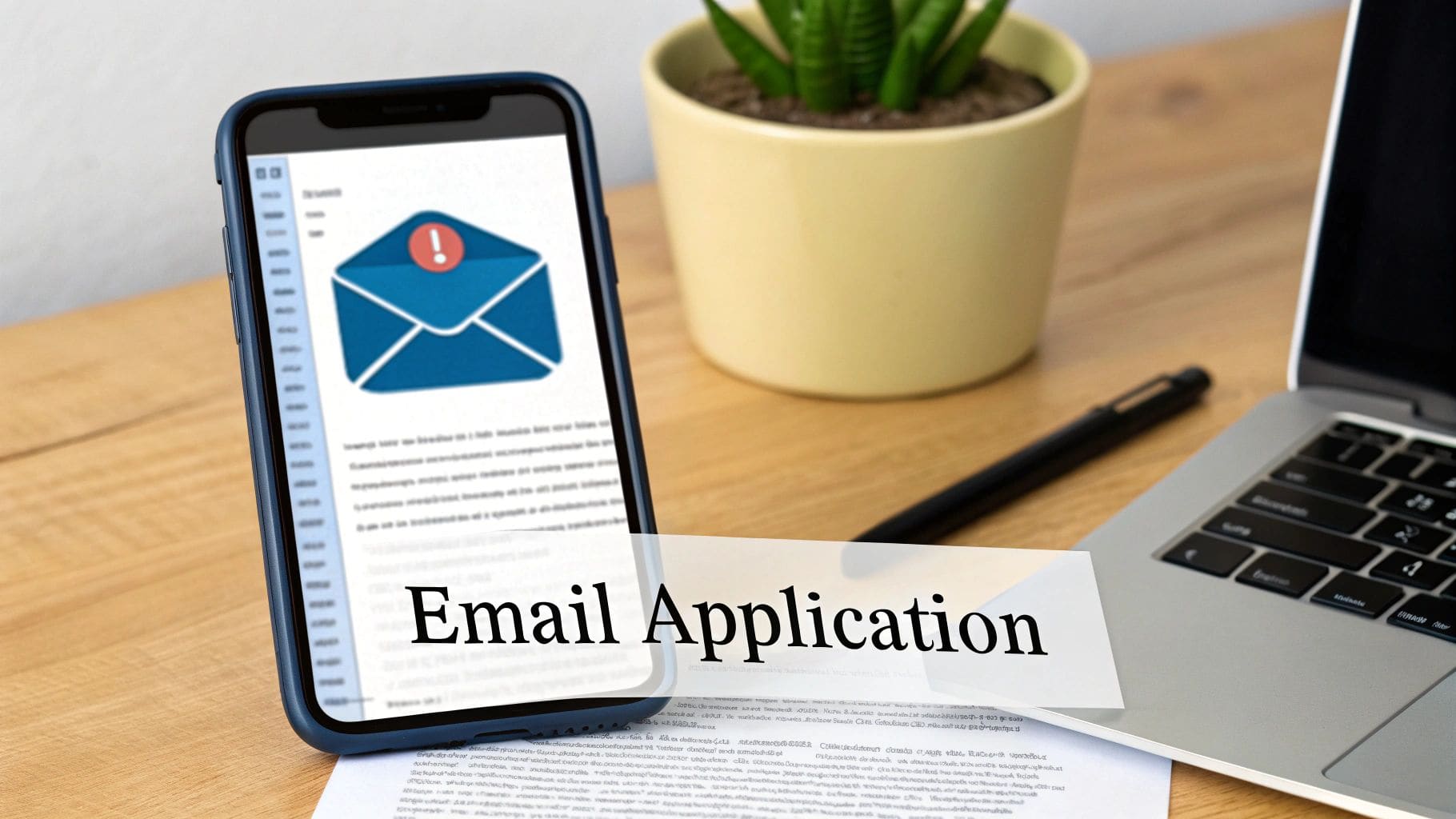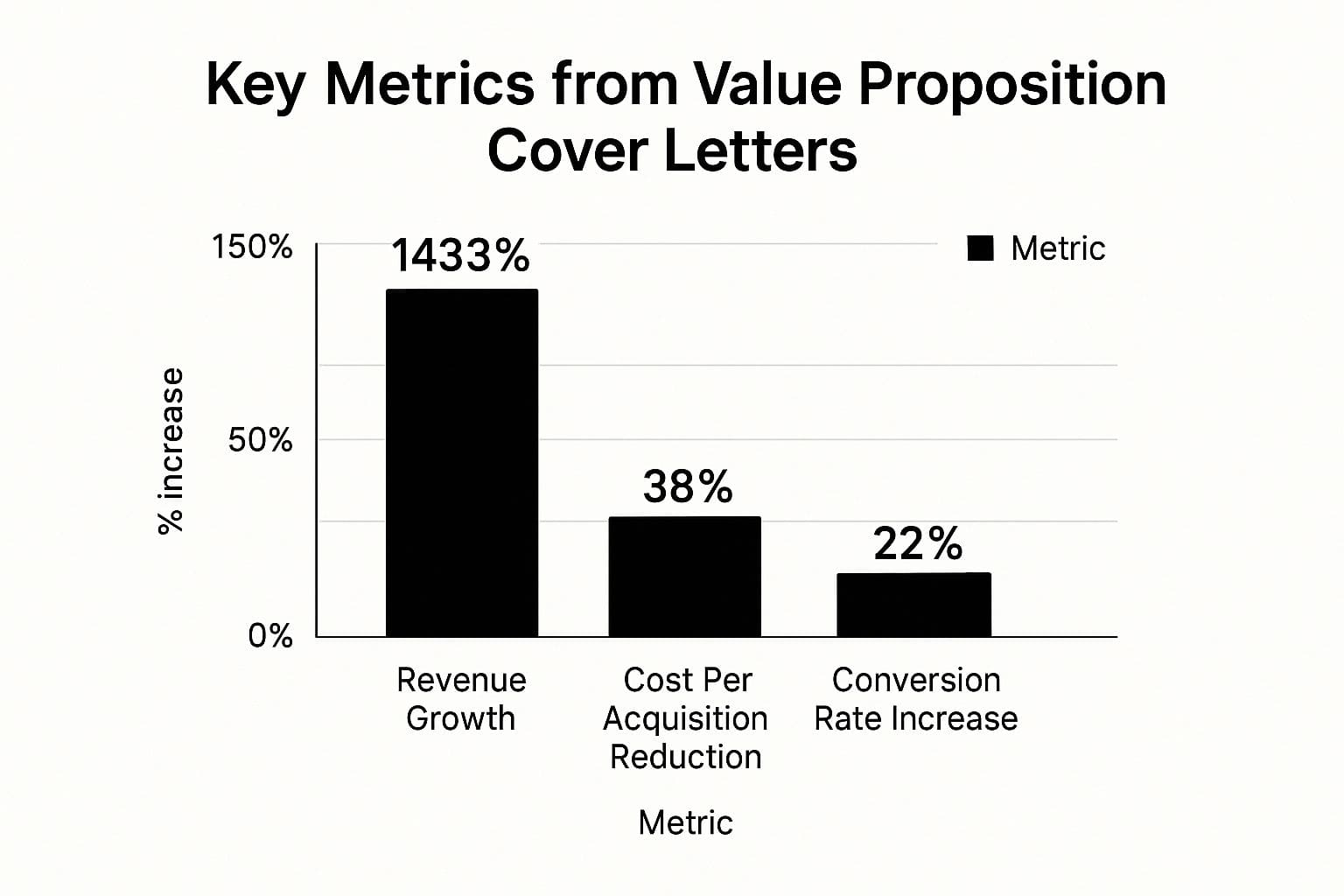8 Essential Cover Letter and Examples for Any Job in 2025
Discover 8 key cover letter and examples, from traditional to creative. Get expert breakdowns and actionable tips to land your next interview.

Stop guessing what recruiters want and start landing interviews with this guide to crafting the perfect cover letter and examples for every situation. Whether you're a recent graduate, a career changer, or a seasoned professional, the right format can make all the difference. A well-crafted cover letter isn't just a formality; it's a critical tool for telling your unique professional story, connecting your skills directly to the employer's needs, and demonstrating your genuine interest. It's your first, and often best, opportunity to stand out from a stack of generic applications. This guide breaks down eight distinct cover letter types with actionable tips.
1. Traditional Professional Cover Letter
The traditional professional cover letter is the cornerstone of formal job applications, especially in established industries like finance, law, government, and academia. This format adheres to a strict business letter structure, projecting an image of professionalism, respect, and serious intent. It's an essential tool when creating a cover letter and examples collection because its classic approach is expected by many corporate and institutional employers, making it a non-negotiable format to master.

This style works by demonstrating your understanding of professional etiquette. It follows a predictable and clear layout: your contact information, the date, the employer's details, a formal salutation, an introductory paragraph, two body paragraphs detailing your qualifications, and a professional closing. Its power lies in its structure and formality, which conveys that you are a candidate who respects process and understands corporate communication norms.
When to Use This Format
Choose this format when applying for roles where tradition and formality are highly valued.
- Corporate roles at Fortune 500 companies like IBM or General Electric.
- Government positions at federal, state, or local levels.
- Legal or financial sector jobs, such as at JPMorgan Chase or a major law firm.
- Academic positions at universities and research institutions.
Actionable Tips for Success
To execute this format effectively, focus on precision and professionalism.
- Addressing: Always address the letter to a specific person. Use "Dear [Mr./Ms./Mx. Last Name]:" instead of a generic greeting.
- Content: Mirror the language from the job description. Use keywords related to the required skills and responsibilities to show you are a direct match. The body of your letter should connect your specific achievements to the company's needs.
- Formatting: Maintain a clean, professional appearance. Use a standard font like Arial or Times New Roman, 10-12 point size, with 1-inch margins.
- Delivery: Always save and send your document as a PDF to preserve its formatting. For a deeper dive into structure, learn more about crafting a traditional professional cover letter.
Get your free CV review
Upload your CV and get instant AI suggestions to improve your chances
2. Email Cover Letter
The email cover letter is a streamlined, modern alternative designed for direct submission within the body of an email. This approach prioritizes brevity and scannability, serving as a concise introduction with your resume attached, rather than requiring the hiring manager to open a separate document. It's a critical format in any cover letter and examples guide because it reflects the fast-paced nature of modern hiring, where recruiters often value quick, direct communication.

This style works by getting straight to the point. Instead of the formal structure of a traditional letter, the body of your email acts as the cover letter itself. Its power lies in its efficiency; it delivers your core message and value proposition immediately, making it easy for a busy recruiter to assess your fit for the role at a glance. It respects the hiring manager's time and demonstrates strong, clear communication skills from the outset.
When to Use This Format
Choose this format for roles in dynamic, fast-moving industries or when the application instructions don't specify a formal letter attachment.
- Tech startup applications where speed and efficiency are highly valued.
- Media or journalism positions at digital-first publications.
- Sales and marketing roles where direct and persuasive communication is key.
- Remote work applications for distributed companies like GitLab or Automattic.
Actionable Tips for Success
To make your email cover letter effective, focus on clarity, conciseness, and professionalism.
- Subject Line: Write a clear, informative subject line. Use a format like "Application for [Job Title] - [Your Name]" to ensure it's easily searchable.
- Content: Keep paragraphs short, ideally just two to three sentences each, to improve readability on all devices. Start by stating the role you're applying for and quickly pivot to your key qualifications.
- Signature: Include your full name, phone number, and a link to your LinkedIn profile in your email signature for easy access.
- Formatting: Avoid using unusual fonts, colors, or images. Stick to plain text to ensure your message displays correctly across different email clients. Always send a test email to yourself first to check formatting.
3. Creative Cover Letter
The creative cover letter is an innovative, visually engaging format designed to break away from traditional structures and showcase personality, design skills, and originality. This approach uses graphics, unique layouts, infographics, or even interactive elements to make a memorable first impression. It is an essential component in any comprehensive guide on cover letter and examples because it demonstrates how to turn an application into a portfolio piece, which is crucial for roles where creativity is a core competency.

This style works by "showing" rather than just "telling." For instance, a graphic designer might use custom illustrations and a unique color palette, while a marketing professional could present their achievements in an infographic. Its power lies in its ability to immediately demonstrate relevant skills. A well-executed creative cover letter proves you are an innovator who understands branding and visual communication before the hiring manager reads a single word.
When to Use This Format
Choose this format when applying for roles in creative industries where a visually compelling application is an advantage.
- Design roles at agencies like Pentagram or Frog Design.
- Marketing or branding positions at innovative companies like Mailchimp or Spotify.
- UX/UI designer roles in the tech sector, where an interactive PDF can showcase skills.
- Content creation or copywriting jobs at media companies like BuzzFeed, where the letter could be a mock ad.
Actionable Tips for Success
To succeed with a creative format, balance innovation with professionalism and clarity.
- Brand Alignment: Research the company's brand aesthetic and align your design with it to show you've done your homework.
- Readability First: Ensure your design choices enhance readability, not hinder it. A beautiful but unreadable letter is ineffective.
- Create a Backup: Always have a plain-text version ready for applicant tracking systems (ATS) that cannot parse complex designs.
- File Size: Keep your file size under 2MB to ensure it can be easily emailed and downloaded.
- Professional Tools: Use professional software like Adobe InDesign or Figma to create a polished final product. For more inspiration, explore a gallery of creative cover letter examples.
4. Career Change Cover Letter
The career change cover letter is strategically designed for professionals transitioning into a new industry or role. This format directly addresses the shift, proactively framing your transferable skills and genuine motivation to ease any potential employer skepticism. It is a vital part of any cover letter and examples collection because it shows how to build a compelling narrative that connects a seemingly unrelated past to a desired future, transforming a potential weakness into a unique strength.
This style works by creating a bridge between your previous experience and the new position. Instead of hiding the transition, you lead with it, explaining the "why" behind your career change. The letter focuses on transferable abilities like project management, communication, or data analysis, and uses achievements from your past career to prove your potential in the new one. Its power lies in its honest and persuasive narrative, which demonstrates self-awareness, passion, and a proactive approach to professional development.
When to Use This Format
Choose this format when your resume shows a significant pivot from one career path to another.
- Industry Switch: A teacher transitioning to a corporate training role at a company like LinkedIn Learning.
- Role Change: A journalist moving into a content marketing or corporate communications position.
- Civilian Transition: A military veteran moving into a civilian project management position.
- Field Pivot: A nurse transitioning to healthcare administration or a medical sales role.
Actionable Tips for Success
To write a persuasive career change cover letter, you must build a strong, logical case for your candidacy.
- Address the Change Immediately: Open your first paragraph by acknowledging the transition. Frame it as a deliberate and enthusiastic move toward a field you are passionate about.
- Tell a Compelling Story: Explain your motivation for the change. Connect your past experiences to your future aspirations, showing the new role is a logical next step in your professional journey.
- Focus on Transferable Skills: Lead with your strongest transferable skills that directly match the job description. For example, a restaurant manager can highlight budget management and team leadership skills for a customer success role.
- Show, Don't Just Tell: Quantify achievements from your previous career that prove your capabilities. A teacher could mention improving student test scores by 20% to demonstrate their ability to drive results in a training role.
- Speak Their Language: Research the new industry's terminology and incorporate it naturally to show you've done your homework. For more guidance, explore how to articulate your transferable skills effectively.
5. Networking/Referral Cover Letter
The networking or referral cover letter is a powerful tool that leverages a mutual connection to immediately capture a hiring manager's attention. Instead of a cold application, this letter opens by mentioning a trusted contact, instantly transferring a degree of credibility to you. This approach is a critical component of any comprehensive guide to a cover letter and examples, as referred candidates are significantly more likely to be hired than other applicants, making this strategy highly effective.
This style works by creating an immediate personal connection and bypassing the anonymity of a typical applicant pool. By starting with a familiar name, such as, "My colleague, Jane Smith, recommended I reach out regarding the Marketing Manager position," you signal that you are a pre-vetted candidate. This strategy's effectiveness lies in its ability to build instant rapport and trust, encouraging the reader to view your application with greater interest and priority.
When to Use This Format
Use this format whenever you have a legitimate professional connection to the company.
- Employee Referrals: When a current employee suggests you apply for a specific role.
- Networking Events: After speaking with a company representative at a conference or career fair.
- LinkedIn Connections: If a mutual contact on a professional network recommends the opportunity.
- Alumni or Industry Contacts: When a professor, mentor, or industry peer from an association encourages you to apply.
Actionable Tips for Success
To maximize the impact of a referral, your approach must be both strategic and respectful.
- Get Permission: Always ask your contact for permission before using their name in your application.
- Be Specific and Upfront: Mention your connection's full name and your relationship to them in the very first paragraph.
- Prove Your Own Merit: While the referral opens the door, you must still thoroughly demonstrate how your skills and experience align with the job requirements.
- Coordinate Efforts: If possible, ask your referrer to notify the hiring manager to expect your application. This creates a powerful two-sided introduction that you can track with a job application tracker.
6. Value Proposition Cover Letter
The value proposition cover letter acts as a business proposal, leading with quantifiable achievements to immediately demonstrate your potential return on investment (ROI). This results-focused format is a powerful tool in any collection of cover letter and examples because it shifts the narrative from your past duties to the future value you will create. It is particularly effective for sales, marketing, and leadership roles where metrics are the primary language of success.
This style works by framing your candidacy as a solution to the employer's problems. Instead of a chronological summary of your experience, you present a compelling case built on specific, measurable results, such as increasing revenue or cutting costs. For instance, a sales professional might lead with, "In my prior role, I expanded territory revenue by 143% in 18 months, securing $2.4M in new business." This direct approach captures attention and proves your ability to deliver tangible outcomes.
The bar chart below visualizes the powerful impact of key metrics often featured in this type of cover letter, such as significant revenue growth and cost reduction.

This visualization highlights how concrete numbers can make a persuasive and immediate argument for your candidacy, directly aligning your skills with business growth and efficiency.
When to Use This Format
Opt for this format when applying for roles where performance is measured by concrete results and ROI is a key consideration.
- Sales and business development roles where revenue generation is the core function.
- Executive or leadership positions where you must prove strategic impact.
- Marketing roles focused on measurable outcomes like customer acquisition cost or conversion rates.
- Operations or consulting jobs where process improvement and savings are critical.
Actionable Tips for Success
To make this format compelling, you must focus on specific, verifiable data that speaks directly to the employer's needs.
- Lead with Impact: Open your letter with your most impressive and relevant quantifiable achievement to grab the reader's attention immediately.
- Use the CAR Method: For each example, structure your accomplishment using Context (the situation), Action (what you did), and Result (the measurable outcome).
- Quantify Everything: Use hard numbers, percentages, and dollar amounts wherever possible. Be prepared to discuss and verify these figures in an interview.
- Format for Scannability: Use bullet points to highlight your key metrics, making them easy for a hiring manager to spot and digest. This is a crucial element when building a cover letter and examples file for future use.
7. Storytelling/Narrative Cover Letter
The storytelling or narrative cover letter moves beyond a simple list of accomplishments, weaving your professional experiences into a compelling story. It engages the hiring manager emotionally by demonstrating your passion, character, and motivation through a personal anecdote. This is a powerful tool to include in any collection of cover letter and examples because it creates a memorable and human connection, setting you apart from candidates who rely solely on facts and figures.
This style works by showing, not telling. Instead of stating you are a "passionate problem-solver," you tell the story of a specific moment that reveals this quality, like resolving a critical bug at 3 AM. Its power lies in its ability to make your qualifications tangible and relatable, illustrating not just what you can do, but why you do it and who you are as a professional.
When to Use This Format
Choose this format for roles where passion, mission alignment, and personal drive are highly valued.
- Non-profit or cause-driven roles, such as at the Bill & Melinda Gates Foundation.
- Creative industries, like marketing, design, or communications.
- Healthcare or education positions, where empathy and dedication are key.
- Startups or companies with a strong mission-driven culture, like Patagonia.
Actionable Tips for Success
To execute this format, your story must be concise, relevant, and emotionally resonant.
- Hook: Start with a compelling opening that drops the reader directly into a specific moment. For example, "The day my struggling reader finished his first chapter book, I knew I had found my calling."
- Connect: Ensure your narrative directly links back to the core requirements of the job. The story should be a clear illustration of a key skill or value mentioned in the job description.
- Show, Don't Tell: Use vivid details to describe the situation, your actions, and the outcome. This makes your experience more impactful than simply listing it as a bullet point on a resume.
- Professionalism: While personal, the story must maintain a professional tone. The goal is to showcase your professional character, not to overshare. This approach provides excellent cover letter and examples of how to blend personality with professional qualifications. For more on this technique, you can explore resources on narrative-driven applications.
8. Cold Contact/Speculative Cover Letter
The cold contact or speculative cover letter is a proactive tool sent to a company that has not advertised a specific open position. It demonstrates initiative, confidence, and a genuine interest in an organization's mission. This approach is a key part of any comprehensive cover letter and examples guide because it allows candidates to create opportunities rather than waiting for them, tapping into the hidden job market where roles are filled before ever being posted publicly.
This style works by shifting the dynamic from reactive applicant to proactive problem-solver. Instead of just listing qualifications, you identify a company's potential need or challenge and position yourself as the solution. For example, a designer might contact a brand they admire by saying, "I've admired Brand X's innovative approach to packaging design for years..." and then propose a new idea. This value-first approach immediately captures attention and sets you apart from the crowd.
When to Use This Format
Use this format when you are targeting a specific company or industry, even if no relevant jobs are listed.
- Targeting dream companies where you are deeply passionate about their work or culture.
- Recent graduates looking to break into competitive fields like tech or marketing at a growing startup.
- Relocating professionals aiming to establish a network in a new city before jobs are advertised.
- Industry experts who can identify and propose new value-add initiatives or roles for an organization.
Actionable Tips for Success
To make a speculative application successful, your approach must be highly personalized and value-driven.
- Research Thoroughly: Reference recent company news, projects, or strategic shifts. Show you've done your homework.
- Identify the Right Person: Send your letter directly to a department head or hiring manager, not a generic HR inbox.
- Focus on Value: Your letter should be concise and answer the question, "How can I help this company?" Frame your skills as solutions to their potential problems.
- Request a Conversation: Instead of asking for a job, ask for a brief conversation to discuss your ideas. For those aiming to stand out, exploring powerful cold email templates can provide a strategic advantage in your speculative outreach.
Cover Letter Types Comparison Overview
| Cover Letter Type | Implementation Complexity 🔄 | Resource Requirements ⚡ | Expected Outcomes 📊 | Ideal Use Cases 💡 | Key Advantages ⭐ |
|---|---|---|---|---|---|
| Traditional Professional Cover Letter | Moderate - formal structure, formatting needed | Medium - knowledge of business writing | Professional impression, comprehensive qualification details | Corporate, government, finance, legal, senior roles | Universally accepted, clear structure, professional tone |
| Email Cover Letter | Low - concise, email-friendly | Low - simple text, resume attachment | Quick recruiter attention, mobile-friendly | Startups, tech, digital marketing, time-sensitive applications | Fast to review, reduces formatting issues, conversational tone |
| Creative Cover Letter | High - design skills, custom layouts | High - design tools and time | Memorable, showcases creativity and design skills | Creative roles: design, marketing, UX/UI, content creation | Stands out visually, demonstrates creativity and technical skill |
| Career Change Cover Letter | Moderate to High - careful framing needed | Medium - research and tailored content | Overcomes skepticism, highlights transferable skills | Mid-career changers, industries open to diverse backgrounds | Addresses transition directly, shows passion and preparation |
| Networking/Referral Cover Letter | Moderate - emphasize connections | Medium - need legitimate contacts | Higher chance of interview, instant credibility | Any roles with internal referrals, competitive industries | Leverages internal trust, often bypasses screening |
| Value Proposition Cover Letter | High - requires quantifiable data | High - data gathering and formulation | Demonstrates ROI, impact, business-focus | Sales, business development, executive & consulting roles | Clear, measurable results, positions candidate as solution |
| Storytelling/Narrative Cover Letter | High - advanced writing skills required | Medium - narrative crafting | Emotional engagement, memorable impression | Writing, communications, mission-driven, empathetic roles | Creates personal connection, authentic and relatable |
| Cold Contact/Speculative Cover Letter | High - research-intensive, no job posting | Medium to High - in-depth company knowledge | Shows initiative, uncovers hidden opportunities | Passive seekers, specialized skills, target companies | Positions as problem solver, accesses hidden job market |
Turn Examples Into Interviews with Smarter Tools
Throughout this guide, we have deconstructed a wide array of cover letter and examples, from the traditional professional format to the bold narrative-driven approach. Each example serves not as a template to be copied, but as a strategic blueprint. By analyzing these diverse styles, you've gained insight into how to modulate your tone, structure your arguments, and align your personal story with a company's specific needs and culture. The ultimate goal is to move beyond generic applications and create a document that truly represents your unique value.
The core lesson from every successful cover letter example is strategic customization. Whether you are changing careers, leveraging a referral, or making a cold speculative pitch, the power lies in your ability to connect your skills directly to the employer's pain points. This requires more than just swapping out a company name; it demands a thoughtful analysis of the job description and a compelling presentation of your qualifications as the ideal solution.
From Blueprint to Application: Your Actionable Next Steps
Mastering the art of the cover letter is a significant competitive advantage. It's your first, and often only, chance to make a human connection before the interview. To translate the knowledge from these cover letter and examples into tangible results, focus on these key actions:
- Deconstruct the Job Description: Before writing a single word, break down the job posting. Identify the top three to five required skills and experiences. These are the pillars around which you will build your cover letter narrative.
- Choose Your Strategic Framework: Based on your situation, select the most appropriate cover letter type. Are you a career changer who needs the Storytelling model? Or a highly qualified candidate who would benefit from the directness of a Value Proposition letter?
- Quantify Your Impact: Move beyond listing duties. Use metrics, percentages, and concrete outcomes to demonstrate your achievements. Instead of "managed social media," try "grew social media engagement by 45% over six months."
- Refine Your Call to Action: End every cover letter with a clear, confident, and proactive closing. Reiterate your enthusiasm and explicitly state your desire to discuss how you can contribute to the company's goals.
For creative roles, the impact of your application extends beyond the written word. Understanding how to present your work visually is paramount. Exploring stellar digital art portfolio examples can provide crucial inspiration on how to build a compelling visual narrative that complements your written application materials.
Ultimately, the powerful cover letter and examples we've explored are designed to do one thing: secure an interview. By internalizing these strategies, you equip yourself to craft targeted, persuasive documents that capture attention and compel hiring managers to learn more. This skill is not just about getting a job; it's about confidently communicating your professional worth at every stage of your career.
Ready to build a truly optimized application? CV Anywhere uses intelligent tools to help you analyze job descriptions, tailor your documents, and ensure every cover letter you send is perfectly aligned for both recruiters and ATS. Stop guessing and start converting examples into interviews with our professional cover letter builder. Want more personalized guidance? Visit CV Anywhere to access our full suite of career tools designed to help you land your next role faster.
Tags
Related Articles
Write a Cover Letter That Actually Gets Read
To write a cover letter that gets read and lands you an interview, you must craft a direct, one-page pitch that solves the company's specific problem. The key is to start with a powerful, personalised...
Read more →7 Winning Examples of an HR Manager Resume to Land an Interview
This guide provides seven distinct examples of an HR manager resume, offering a detailed breakdown of each structure complete with strategic analysis and actionable takeaways. We'll move beyond generi...
Read more →Cover Letter Examples Sample: 8 Proven Templates to Land Interviews
Cover Letter Examples Sample: 8 Proven Templates to Land Interviews This guide provides 8 proven cover letter example samples, each with a strategic breakdown, to help you write a compelling applicati...
Read more →Popular Articles
A powerful job application tracking spreadsheet is your secret weapon, turning the chaos of a job hunt into a strategic, organised campaign. Think of it less as a simple list and more as a dynamic com...
Figuring out how to list your education on a resume is a strategic move. Where you place it is one of the first things a recruiter's eyes will land on, and you've got about seven seconds to convince t...
Using an ATS resume template means designing a CV for a robot's eyes first. It's a clean, straightforward document created specifically to be read and understood by Applicant Tracking Systems (ATS). B...
To get your ATS friendly CV UK employers will actually see, you need a CV that's simple, predictable, and incredibly easy for software to read. Applicant Tracking Systems (ATS) are software, not peopl...
Crafting a compelling post grad resume when you're fresh out of uni can feel like a catch-22. You need experience to get a job, but you need a job to get experience. The secret is that your resume isn...